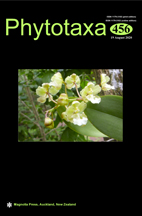Abstract
We describe and illustrate Paepalanthus campanulatus, a new species of Eriocaulaceae from the Chapada dos Veadeiros National Park (Goiás, Brazil). The species is known from a single population with many individuals growing under rocks and in small caves, sometimes upside down attached to the top of the cave. The new species is mainly distinguished by its usually tiny, unbranched stem bearing a fasciculate inflorescence composed of mostly glabrous, campanulate capitula surrounded by whitish hyaline involucral bracts. Due to its very restricted distribution, the species may be considered endangered. It is compared with Paepalanthus albidus and P. subtilis, the morphologically most similar species. We provide details on the leaf and scape anatomy of these species, as well as comments on the distribution, habitat, ecology, and morphological variation, along with line drawings and photos of the new species.

